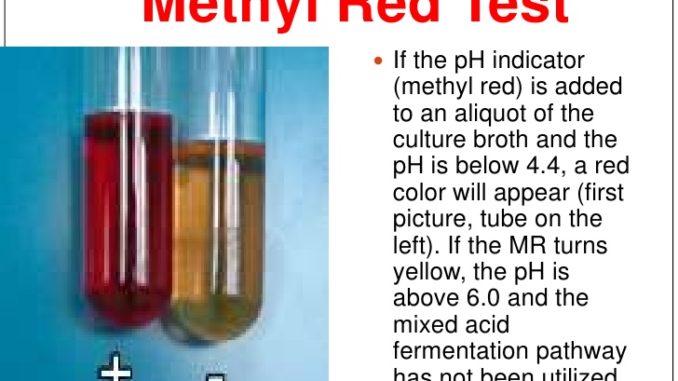
Methyl red (MR) test:
Objective:
- To check whether the organism follow mixed acid fermentation pathway during their metabolism or not
Principle of MR test:
The basic principle of MR test is to check the ability of the organism to produce and maintain sufficient amount of stable acid as end product from glucose fermentation and to overcome the buffering capacity of the system.
Among different fermentation pathway followed by bacteria, MR test works upon the mixed acid fermentation pathway.
Glucose———–> 2 pyruvate———–> succinic acid, lactic acid, acetic acid, formic acid + CO2 + H2O
These acids lowers the pH of the medium which is nearly neutral. The pH range of the methyl red indicator is 4.4-6. The production of acids lowers the pH of medium so the methyl red indicator changes it color to red but if there is no or low production of acids or production of other neutral end products, the pH of the medium remains fairly unchanged and the indicator shows yellow color. Hence, the red color of the broth medium after adding indicator is positive MR test.
Requirements:
- Media: MR-VP broth
- Culture: 24 hr culture ofcoli and Klebsiella
- Reagent: methyl red indicator
Procedure of MR test:
- Prepare MRVP broth in test tubes
- Inoculate the broth aseptically with 2 loopful of respective bacterial culture
- Label the test tubes with name of organism inoculated
- Incubate the test tubes at 37°C for 48-72 hours.
- Add few drops of methyl red indicator in the incubated tubes
- Observe the results
Result:

MR test positive: bright red color (E.coli)
MR test negative: yellow color ( Klebsiella )
**MR positive are: E. coli, Streptococcus mitis, Citrobacter sp., Shigella, Yersinia, Edwardsiella, Salmonella, Vibrio furnissii, Vibrio fluvialis, Vibrio vulnificus, and Vibrio parahaemolyticus
